Page 347 of 426
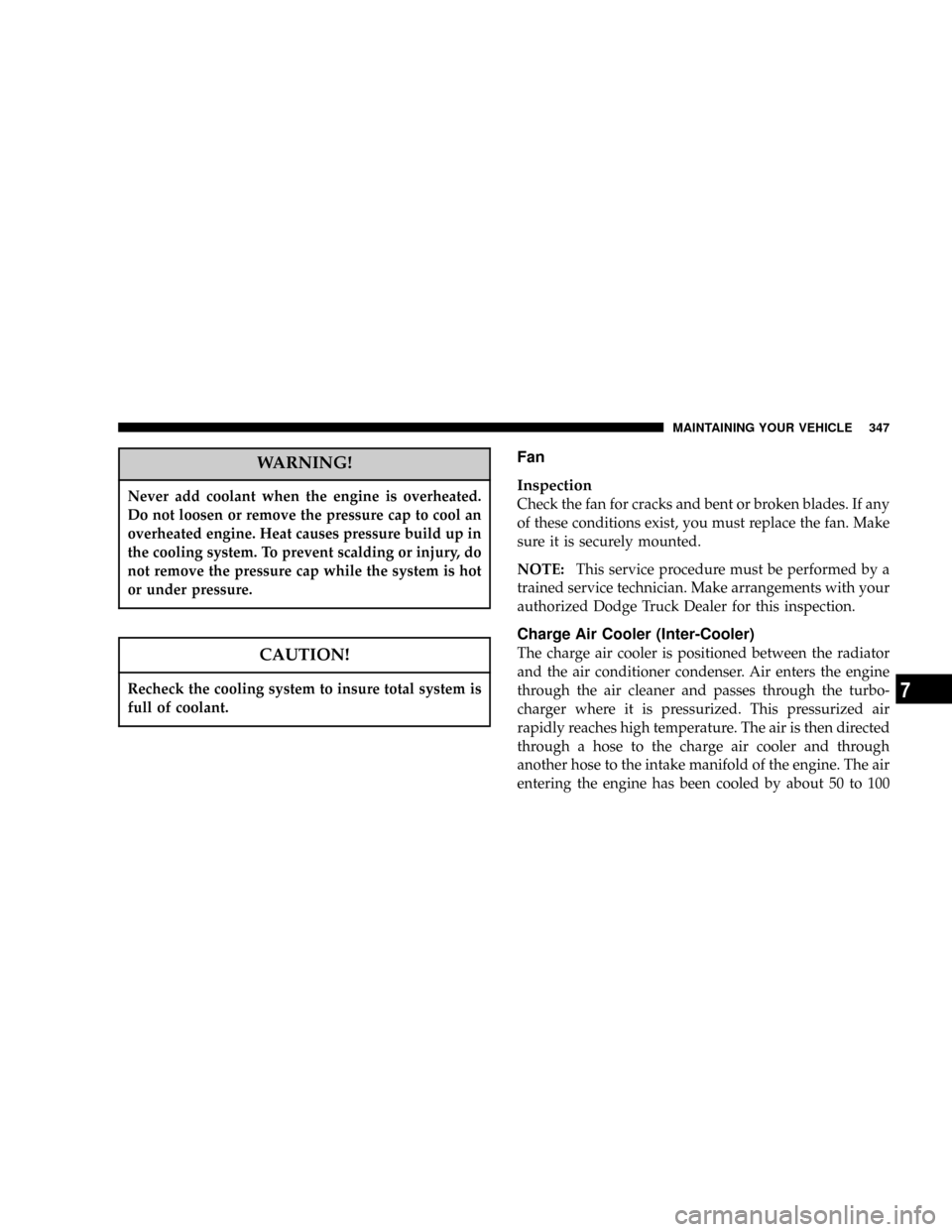
WARNING!
Never add coolant when the engine is overheated.
Do not loosen or remove the pressure cap to cool an
overheated engine. Heat causes pressure build up in
the cooling system. To prevent scalding or injury, do
not remove the pressure cap while the system is hot
or under pressure.
CAUTION!
Recheck the cooling system to insure total system is
full of coolant.
Fan
Inspection
Check the fan for cracks and bent or broken blades. If any
of these conditions exist, you must replace the fan. Make
sure it is securely mounted.
NOTE:This service procedure must be performed by a
trained service technician. Make arrangements with your
authorized Dodge Truck Dealer for this inspection.
Charge Air Cooler (Inter-Cooler)
The charge air cooler is positioned between the radiator
and the air conditioner condenser. Air enters the engine
through the air cleaner and passes through the turbo-
charger where it is pressurized. This pressurized air
rapidly reaches high temperature. The air is then directed
through a hose to the charge air cooler and through
another hose to the intake manifold of the engine. The air
entering the engine has been cooled by about 50 to 100
MAINTAINING YOUR VEHICLE 347
7
Page 348 of 426

degrees Fahrenheit. This cooling process enables more
efficient burning of fuel resulting in fewer emissions.
To guarantee optimum performance of the system, keep
the surfaces of the charge air cooler, condenser and
radiator clean and free of debris. Periodically check the
hoses leading to and from the charge air cooler for cracks
or loose clamps resulting in loss of pressure and reduced
engine performance.
Hoses And Vacuum/Vapor Harnesses
Inspect surfaces of hoses and nylon tubing for evidence
of heat and mechanical damage. Hard or soft spots,
brittle rubber, cracking, tears, cuts, abrasions, and exces-
sive swelling indicate deterioration of the rubber.
Pay particular attention to those hoses nearest to high
heat sources such as the exhaust manifold. Inspect hose
routing to be sure hoses do not come in contact with any
heat source or moving component which may cause heat
damage or mechanical wear.Insure nylon tubing in these areas has not melted or
collapsed.
Inspect all hose connections such as clamps and cou-
plings to make sure they are secure and no leaks are
present.
Components should be replaced immediately if there is
any evidence of wear or damage that could cause failure.
Brake System
Power Disc Brakes (Front and Rear)
Disc brakes do not require adjustment; however, several
hard stops during the break-in period are recommended
to seat the linings and wear off any foreign material.
Brake Master Cylinder
The fluid level of the master cylinder should be checked
when performing under the hood service, or immedi-
ately if the brake system warning lamp indicates system
failure.
348 MAINTAINING YOUR VEHICLE
Page 350 of 426
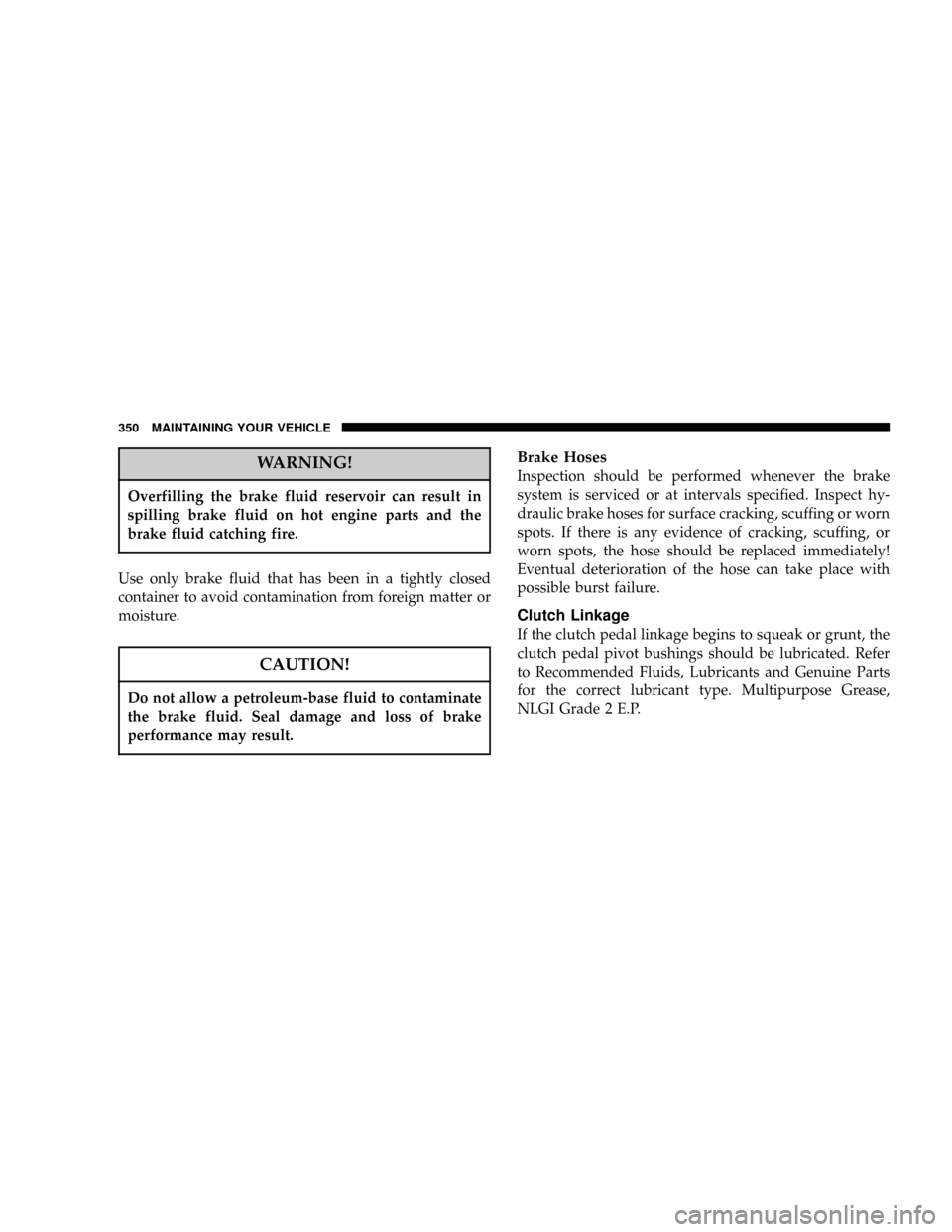
WARNING!
Overfilling the brake fluid reservoir can result in
spilling brake fluid on hot engine parts and the
brake fluid catching fire.
Use only brake fluid that has been in a tightly closed
container to avoid contamination from foreign matter or
moisture.
CAUTION!
Do not allow a petroleum-base fluid to contaminate
the brake fluid. Seal damage and loss of brake
performance may result.
Brake Hoses
Inspection should be performed whenever the brake
system is serviced or at intervals specified. Inspect hy-
draulic brake hoses for surface cracking, scuffing or worn
spots. If there is any evidence of cracking, scuffing, or
worn spots, the hose should be replaced immediately!
Eventual deterioration of the hose can take place with
possible burst failure.
Clutch Linkage
If the clutch pedal linkage begins to squeak or grunt, the
clutch pedal pivot bushings should be lubricated. Refer
to Recommended Fluids, Lubricants and Genuine Parts
for the correct lubricant type. Multipurpose Grease,
NLGI Grade 2 E.P.
350 MAINTAINING YOUR VEHICLE
Page 351 of 426
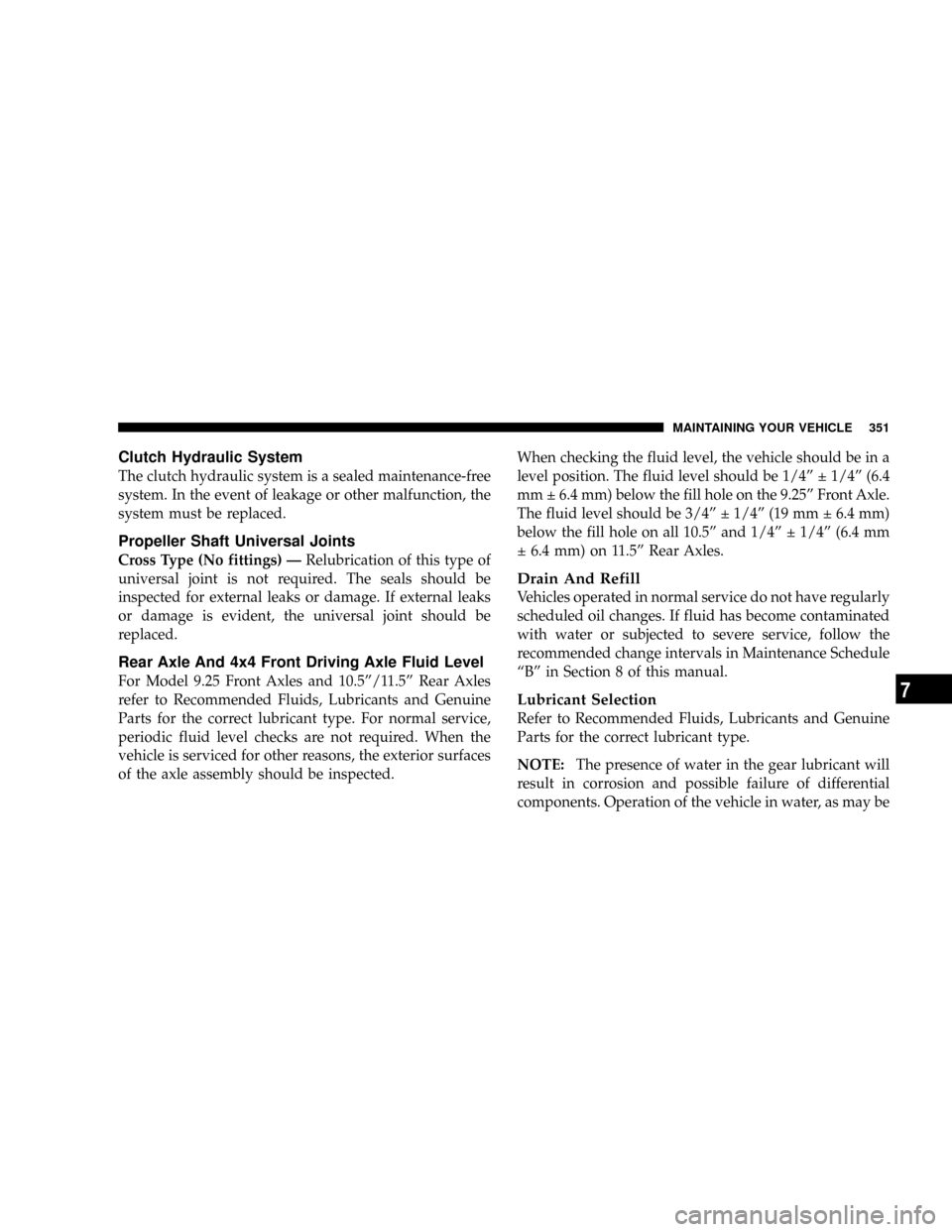
Clutch Hydraulic System
The clutch hydraulic system is a sealed maintenance-free
system. In the event of leakage or other malfunction, the
system must be replaced.
Propeller Shaft Universal Joints
Cross Type (No fittings) ÐRelubrication of this type of
universal joint is not required. The seals should be
inspected for external leaks or damage. If external leaks
or damage is evident, the universal joint should be
replaced.
Rear Axle And 4x4 Front Driving Axle Fluid Level
For Model 9.25 Front Axles and 10.5º/11.5º Rear Axles
refer to Recommended Fluids, Lubricants and Genuine
Parts for the correct lubricant type. For normal service,
periodic fluid level checks are not required. When the
vehicle is serviced for other reasons, the exterior surfaces
of the axle assembly should be inspected.When checking the fluid level, the vehicle should be in a
level position. The fluid level should be 1/4º 1/4º (6.4
mm 6.4 mm) below the fill hole on the 9.25º Front Axle.
The fluid level should be 3/4º 1/4º (19 mm 6.4 mm)
below the fill hole on all 10.5º and 1/4º 1/4º (6.4 mm
6.4 mm) on 11.5º Rear Axles.
Drain And Refill
Vehicles operated in normal service do not have regularly
scheduled oil changes. If fluid has become contaminated
with water or subjected to severe service, follow the
recommended change intervals in Maintenance Schedule
ªBº in Section 8 of this manual.
Lubricant Selection
Refer to Recommended Fluids, Lubricants and Genuine
Parts for the correct lubricant type.
NOTE:The presence of water in the gear lubricant will
result in corrosion and possible failure of differential
components. Operation of the vehicle in water, as may be
MAINTAINING YOUR VEHICLE 351
7
Page 352 of 426

encountered in some off-highway types of service, will
require draining and refilling the axle to avoid damage.
Limited-Slip Differentialsin vehicles equipped with
10.5º/11.5º AxlesDO NOT REQUIREany limited slip
oil additive (friction modifiers).
Transfer Case Ð If Equipped
Fluid Level Check
This fluid level can be checked by removing the filler
plug. The fluid level should be to the bottom edge of the
filler plug hole with the vehicle in a level position.
Lubricant Selection
Refer to Recommended Fluids, Lubricants and Genuine
Parts for the correct lubricant type.
Manual Transmission Ð If Equipped
Fluid Level Check
This fluid level can be checked by removing the filler
plug. If the level of the lubricant is more than 1/4º below
the bottom of the filler hole while the vehicle is on level
ground, enough lubricant should be added to bring the
level to the bottom of the filler hole.
Lubricant Selection for NV-4500 (5-Speed Manual
Transmission) Ð If Equipped
This transmission does not require periodic changing. If
it becomes necessary to add fluid or change the fluid, be
sure to use the same lubricant or equivalent. Refer to
Recommended Fluids, Lubricants and Genuine Parts for
the correct lubricant type.
352 MAINTAINING YOUR VEHICLE
Page 353 of 426
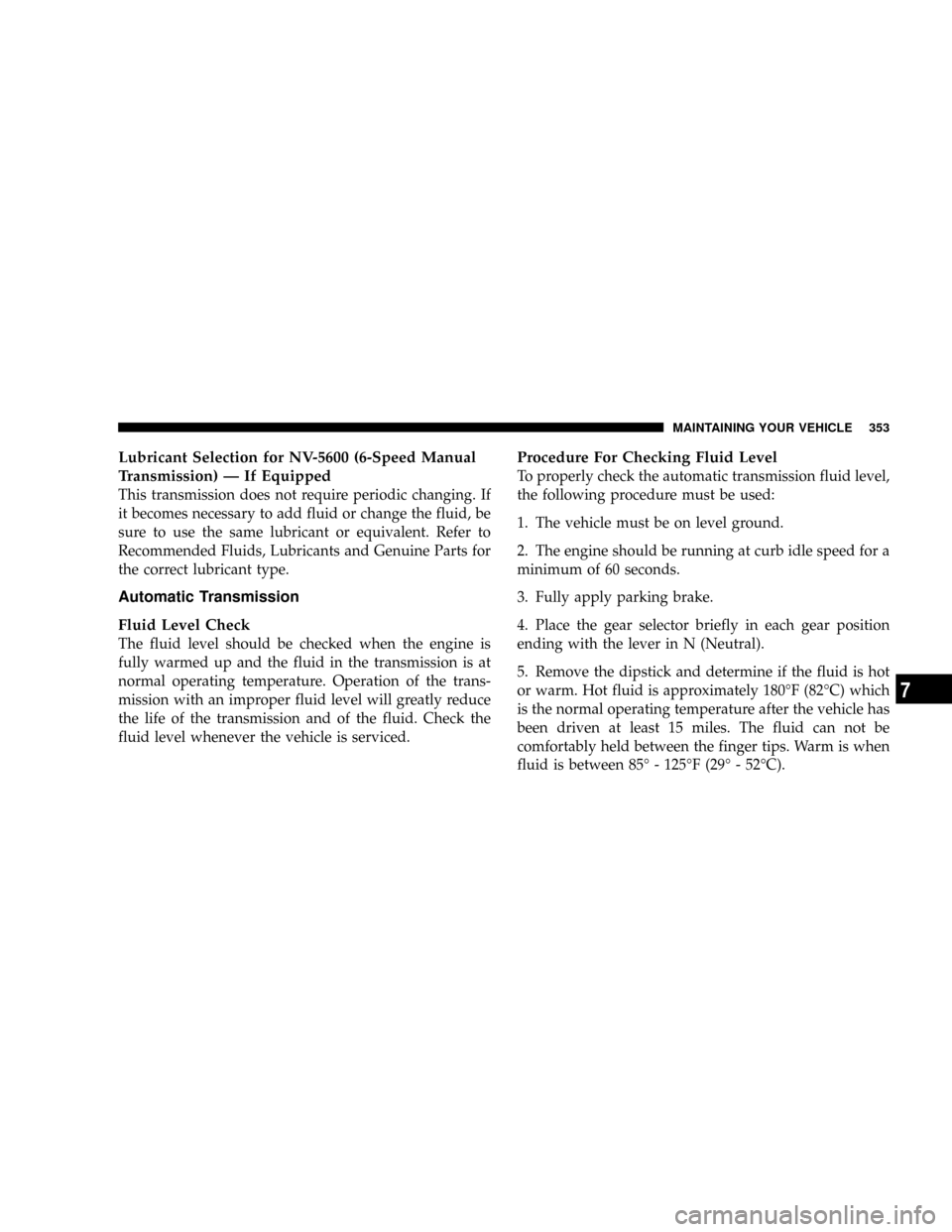
Lubricant Selection for NV-5600 (6-Speed Manual
Transmission) Ð If Equipped
This transmission does not require periodic changing. If
it becomes necessary to add fluid or change the fluid, be
sure to use the same lubricant or equivalent. Refer to
Recommended Fluids, Lubricants and Genuine Parts for
the correct lubricant type.
Automatic Transmission
Fluid Level Check
The fluid level should be checked when the engine is
fully warmed up and the fluid in the transmission is at
normal operating temperature. Operation of the trans-
mission with an improper fluid level will greatly reduce
the life of the transmission and of the fluid. Check the
fluid level whenever the vehicle is serviced.
Procedure For Checking Fluid Level
To properly check the automatic transmission fluid level,
the following procedure must be used:
1. The vehicle must be on level ground.
2. The engine should be running at curb idle speed for a
minimum of 60 seconds.
3. Fully apply parking brake.
4. Place the gear selector briefly in each gear position
ending with the lever in N (Neutral).
5. Remove the dipstick and determine if the fluid is hot
or warm. Hot fluid is approximately 180ÉF (82ÉC) which
is the normal operating temperature after the vehicle has
been driven at least 15 miles. The fluid can not be
comfortably held between the finger tips. Warm is when
fluid is between 85É - 125ÉF (29É - 52ÉC).
MAINTAINING YOUR VEHICLE 353
7
Page 354 of 426
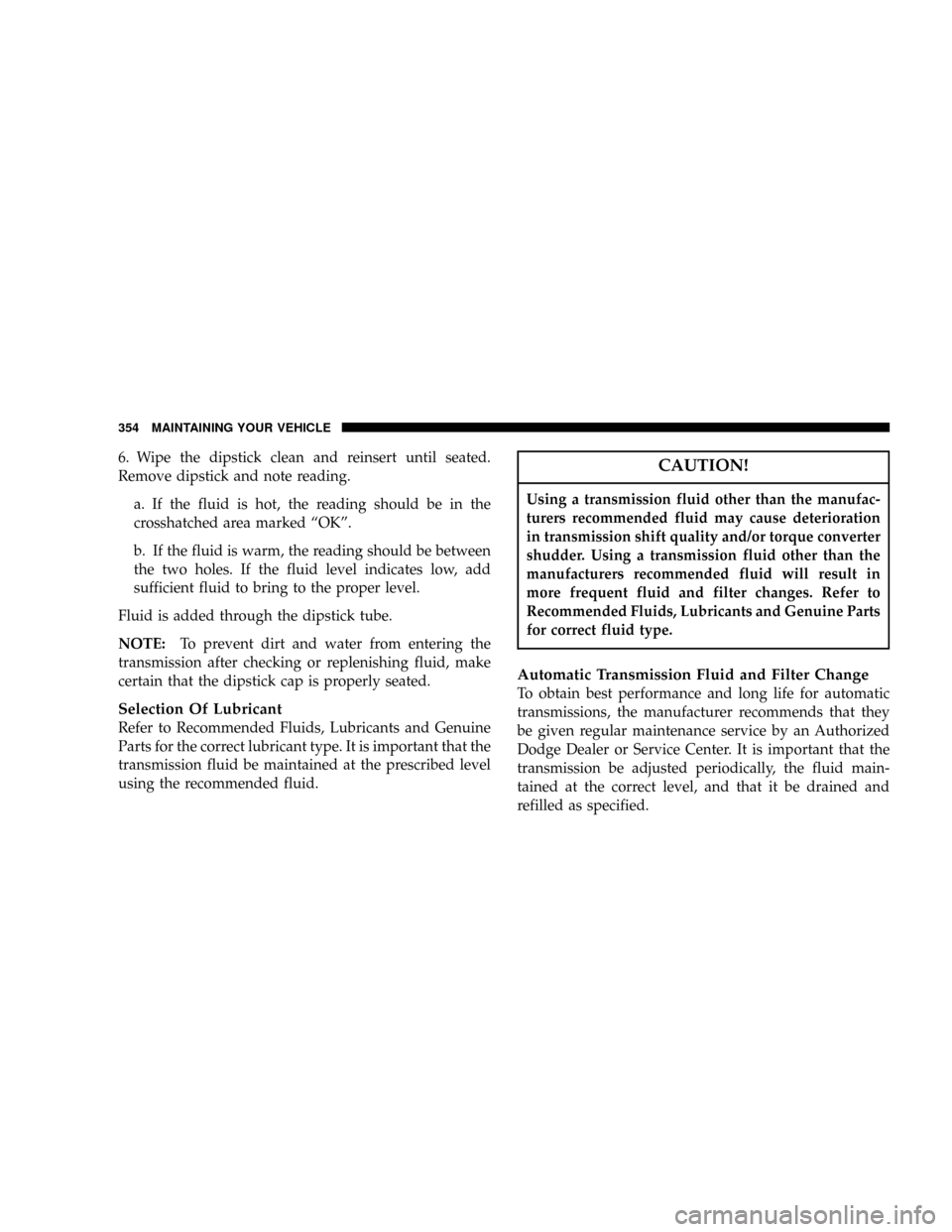
6. Wipe the dipstick clean and reinsert until seated.
Remove dipstick and note reading.
a. If the fluid is hot, the reading should be in the
crosshatched area marked ªOKº.
b. If the fluid is warm, the reading should be between
the two holes. If the fluid level indicates low, add
sufficient fluid to bring to the proper level.
Fluid is added through the dipstick tube.
NOTE:To prevent dirt and water from entering the
transmission after checking or replenishing fluid, make
certain that the dipstick cap is properly seated.
Selection Of Lubricant
Refer to Recommended Fluids, Lubricants and Genuine
Parts for the correct lubricant type. It is important that the
transmission fluid be maintained at the prescribed level
using the recommended fluid.
CAUTION!
Using a transmission fluid other than the manufac-
turers recommended fluid may cause deterioration
in transmission shift quality and/or torque converter
shudder. Using a transmission fluid other than the
manufacturers recommended fluid will result in
more frequent fluid and filter changes. Refer to
Recommended Fluids, Lubricants and Genuine Parts
for correct fluid type.
Automatic Transmission Fluid and Filter Change
To obtain best performance and long life for automatic
transmissions, the manufacturer recommends that they
be given regular maintenance service by an Authorized
Dodge Dealer or Service Center. It is important that the
transmission be adjusted periodically, the fluid main-
tained at the correct level, and that it be drained and
refilled as specified.
354 MAINTAINING YOUR VEHICLE
Page 357 of 426
Noise Control System Required Maintenance &
Warranty
For 3500 Two-Wheel Drive and Four-Wheel Drive mod-
els over 10,000 lbs. (4 535 kg) Gross Vehicle Weight
Rating.
All vehicles built over 10,000 lbs. (4 535 kg) Gross Vehicle
Weight Rating and manufactured for sale and use in the
United States are required to comply with the Federal
Government's Exterior Noise Regulations. These vehicles
can be identified by the Noise Emission Control Label
located in the operator's compartment.
Required Maintenance For Noise Control Systems
The following maintenance services must be performed
every 6 months or 6,000 miles (9 600 km), whichever
comes first, to assure proper operation of the noise
control systems. In addition, inspection and service
should be performed anytime a malfunction is observed
MAINTAINING YOUR VEHICLE 357
7